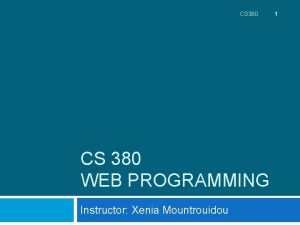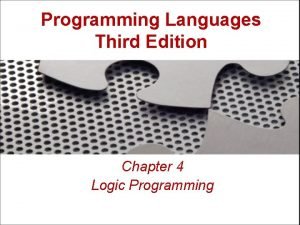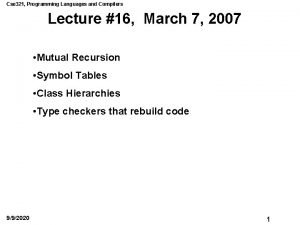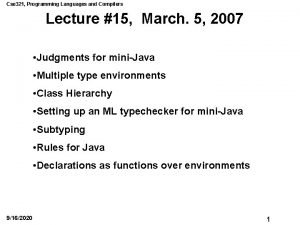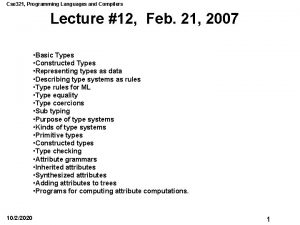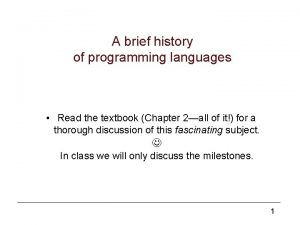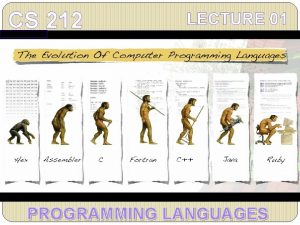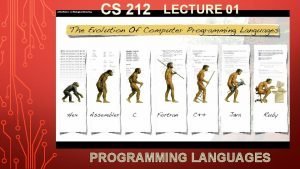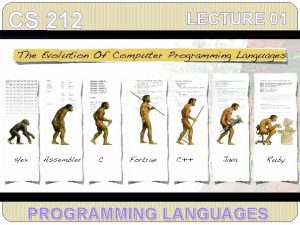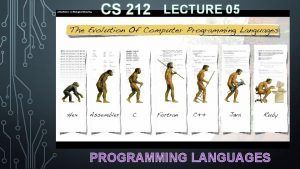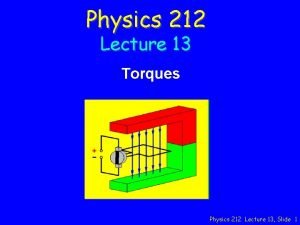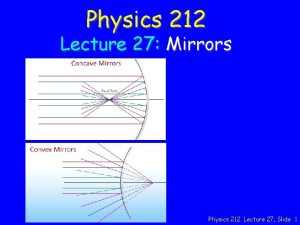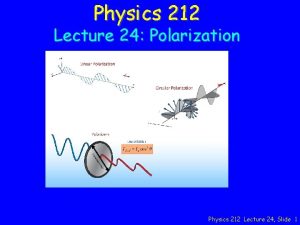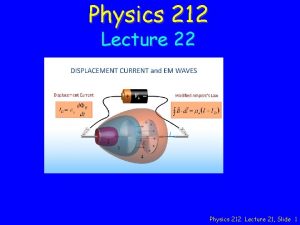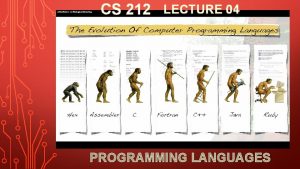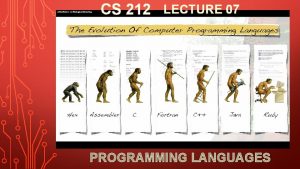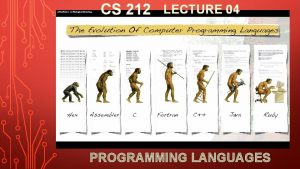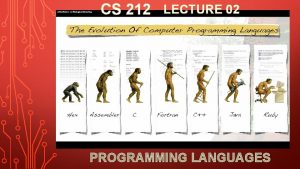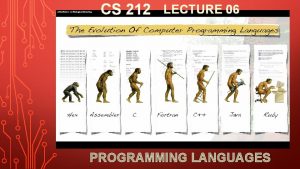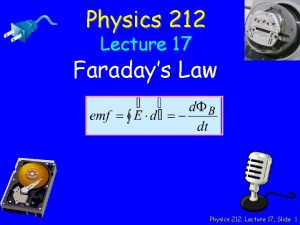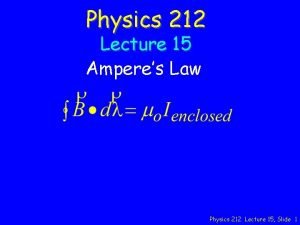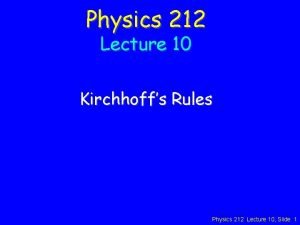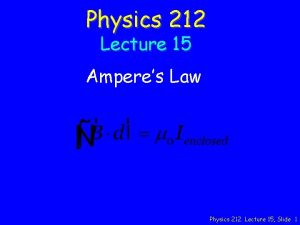CS 212 LECTURE 03 PROGRAMMING LANGUAGES GRAMMAR It























- Slides: 23

CS 212 LECTURE 03 PROGRAMMING LANGUAGES

GRAMMAR • It is often convenient to specify languages in terms of grammars. The advantage in doing so arises mainly from the usage of a small number of rules for describing a language with a large number of sentences. For instance, the possibility that an English sentence consists of a subject phrase followed by a predicate phrase can be expressed by a grammatical rule of the form 2

GRAMMAR <sentence> <noun-phrase><verb-phrase> <noun-phrase> <article><adjective><noun> <noun-phrase> <article><noun> <verb-phrase> <verb><adverb> | <verb> <article> a | the <adjective> large | hungry <noun> rabbit | mathematician <verb> eat | hops <adverb> quickly | wildly 3

GRAMMAR • From these rules we can form valid sentences using a series of replacements until no more rules can be used. • Example, the sentence is “the large rabbit hops quickly” we start with the rule : <sentence> <noun-phrase><verb-phrase> <article><adjective><noun><verb-phrase> 4

GRAMMAR àthe large<noun> <verb-phrase> àthe large rabbit <verb><adverb> àthe large rabbit hops quickly Let try this sentence : “a hungry mathematician eats wildly” 5

GRAMMAR Let move to the formal definition of grammar Definition : A grammar < , N, P, S> consists of four parts: 1. A finite set of terminal symbols , the alphabet of the language, that are assembled to make up the sentences in the language. 2. A finite set N of nonterminal symbols , each of which represents some collection of subphrases of 6 sentences.

GRAMMAR Let move to the formal definition of grammar Definition : A grammar < , N, P, S> consists of four parts: 7

CLASSIFICATION OF GRAMMAR • Chomsky classified grammars according to the structure of their productions, suggesting four forms of particular usefulness, calling them type 0 through type 3 • Type 0 : The most general grammars, the unrestricted grammars , require only that at least one nonterminal occur on the left side of a rule where α and β are strings of symbols in and α is not the empty string, and 8

TYPE 0 : EXAMPLE Let = { a, b }, N = { A, B, S } , S = { S } P = S ABa , A BB , B ab , AB b 9

CLASSIFICATION OF GRAMMAR • Type 1 : When we add the restriction that the right side contains no fewer symbols than the left side, we get the context-sensitive grammars—for example, a rule of the form αβ → αγβ where α, β ∈ (N U Σ)+ (i. e. , α and β are strings of nonterminals and terminals) and γ ∈ (N U Σ)+ (i. e. , γ is a nonempty string of 10 nonterminals and terminals).

TYPE 1 : EXAMPLE = { a, b, c } , N ={ S, B, C } P= S a. Sbc S a. BC a. B ab b. C bc cb bc This type 1 grammar is generate string anbncn where n 1 11

CLASSIFICATION OF GRAMMAR • Type 2 : The context-free grammars prescribe that the left side be a single nonterminal producing rules of the form A → w where A ∈ N (i. e. , A is a single nonterminal), w ∈ (N U Σ)* (i. e. , w are strings of nonterminals and terminals) 12

TYPE 2 : EXAMPLE = { a, b } , N ={ S, A} P = S b. Sbb S A A a. A A This type 2 grammar is generate string 13

CLASSIFICATION OF GRAMMAR • Type 3 : The most restrictive grammars, the regular grammars , allow only a terminal or a terminal followed by one nonterminal on the right side—that is, rules of the form • A → a - where A is a non-terminal in N and a is a terminal in Σ • A → a. B - where A and B are in N and a is in Σ • A → - where A is in N and denotes the empty string, i. e. the string of length 0. 14

TYPE 3 : EXAMPLE = { a, b, c } , N ={ S, A } P= S → a. S S → b. A A→ A → c. A This type 3 grammar is generate string a*bc * 15

DERIVATIONS • The cfg G that generates the language consisting of strings over ={a, b} with a even number of a G = ( , N, P, S) , N={S, A} , ={a, b} P : S AA A AAA | b. A | Ab | a we want to generate string ababaa, we will write its derivation. So, we have two types of derivation which are leftmost and rightmost derivation. 16

DERIVATIONS S=> AA => a. AAA => aba. AA => ababaa Leftmost S=> AAAA => aba. AA => ababaa Left most S=> AA => Aa => AAbaa => Ab. Abaa => Ababaa => ababaa Rightmost 17

CFG EXAMPLE �The cfg G that generates the language consisting of strings over ={0, 1} G = ( , N, P, S) , N={A, B} , ={0, 1} , S={A} P: A B | B 0 A 1 we want to generate string 000111, write its leftmost or rightmost derivation. 18

DERIVATIONS Leftmost derivation A => B => 0 A 1 => 0 B 1 => 00 A 11 => 00 B 11 => 000 A 111 => 000111 19

Some Pascal production rules <expression> <simple expression> <term> | <sign><term> | <simple expression><adding operator><term> <adding operator> + | <multiplying operator> * | / | div | mod <term> <factor> | <term><multiplying operator><factor> <identifier> | <unsigned constant> | (<expression>) 20

<unsigned constant> <unsigned number> <unsigned integer> | <unsigned real> <unsigned integer> <digit><unsigned integer> | <digit > <identifier> <letter><identifier tail>| <digit><identifier tail> | <sign> + | <digit> 0 | 1 | 2 |…| 9 <letter> a | b | c | … | z 21

Example : Uses Pascal production rules to find the leftmost derivation that given the constant 65. Derivation is <expression> <simple expression> <term> <factor> <unsigned constant> <unsigned number> <unsigned integer> <digit><unsigned integer> 6<digit> 65 22

TRY THIS • Uses Pascal production rules to find the leftmost derivation that given -250. • Uses Pascal production rules to find the leftmost derivation that given 5 * ( x + 15 ) • Uses Pascal production rules to find the leftmost derivation that given ( (x – 10) div 2 ) • Uses Pascal production rules to find the leftmost derivation that given – 125 /( x 1 div 2 ) 23
 Attribute grammar in principles of programming languages
Attribute grammar in principles of programming languages 01:640:244 lecture notes - lecture 15: plat, idah, farad
01:640:244 lecture notes - lecture 15: plat, idah, farad Real-time systems and programming languages
Real-time systems and programming languages Cs 421
Cs 421 Multithreaded programming languages
Multithreaded programming languages Cxc it
Cxc it Introduction to programming languages
Introduction to programming languages Plc programming languages
Plc programming languages Procedural programming languages
Procedural programming languages Imperative programming languages
Imperative programming languages Alternative programming languages
Alternative programming languages Strongly typed vs weakly typed
Strongly typed vs weakly typed Transmission programming languages
Transmission programming languages Adam doupe cse 340
Adam doupe cse 340 Integral data type is
Integral data type is Xenia programming languages
Xenia programming languages Advantages and disadvantages of system software
Advantages and disadvantages of system software Mainstream programming languages
Mainstream programming languages Cse 340 principles of programming languages
Cse 340 principles of programming languages Programming languages
Programming languages Programming languages
Programming languages Programming languages
Programming languages Programming languages
Programming languages Brief history of programming languages
Brief history of programming languages















